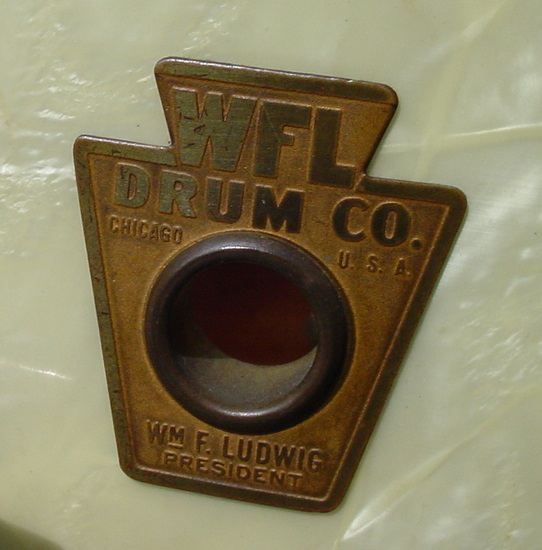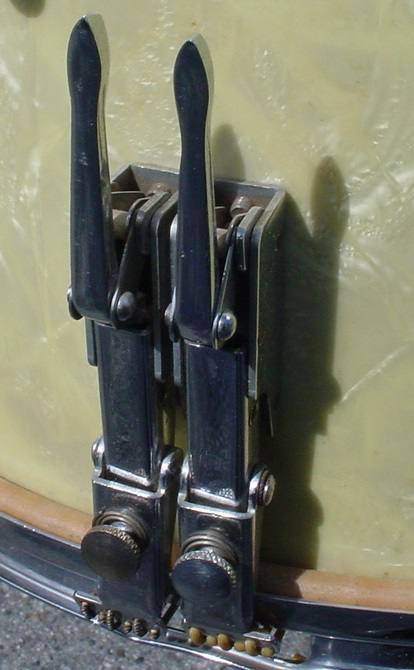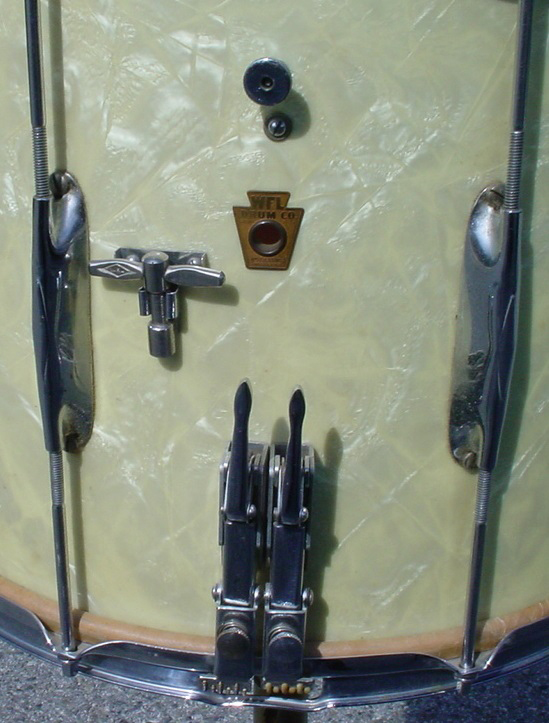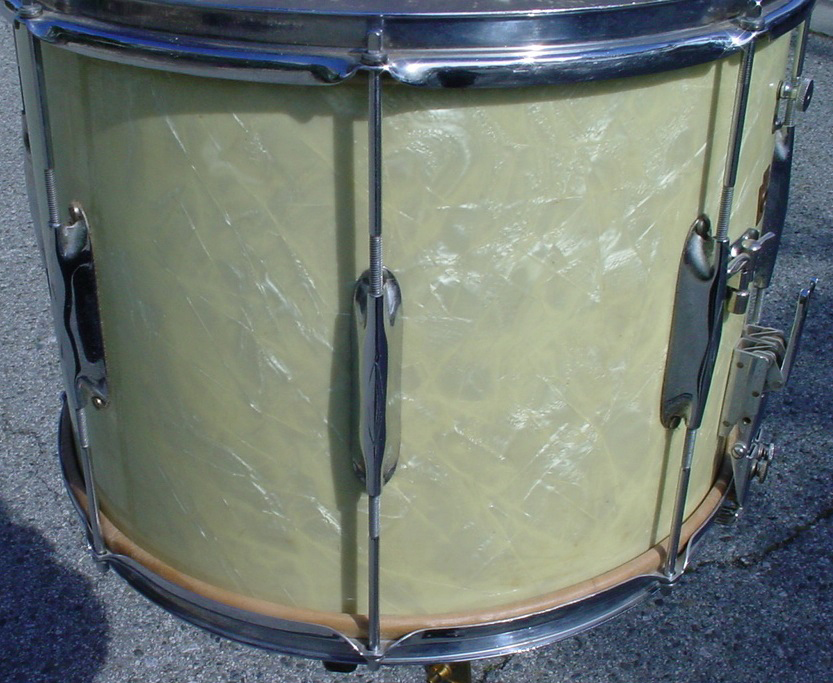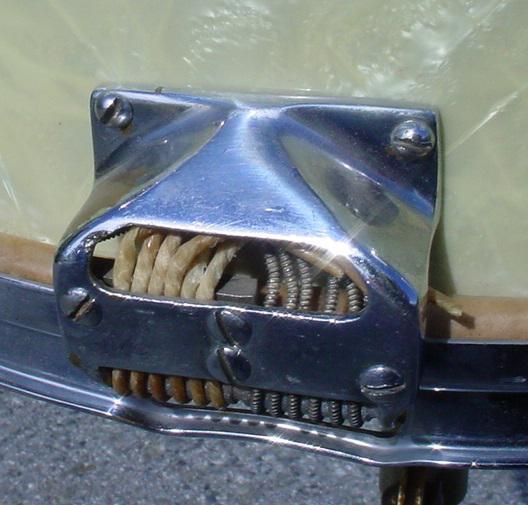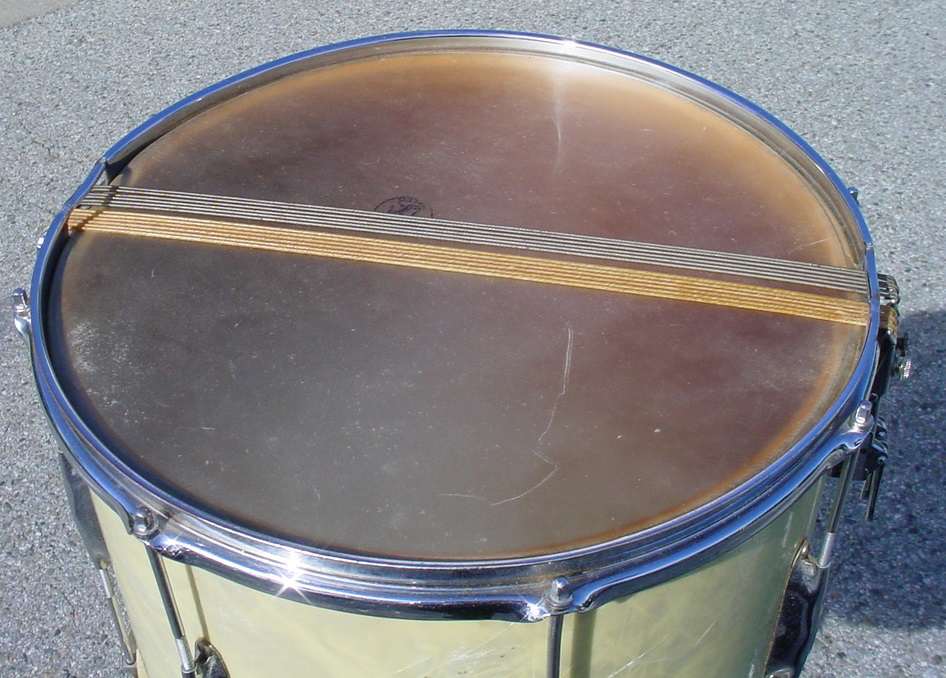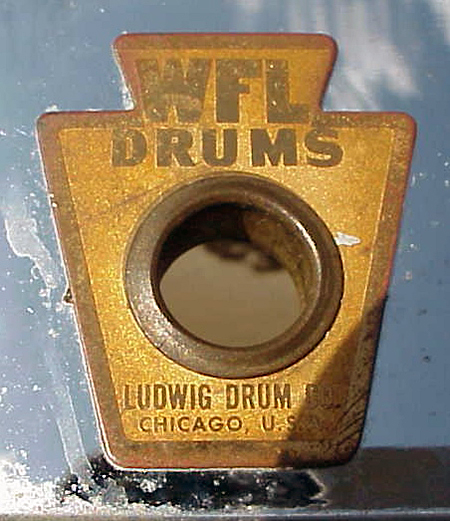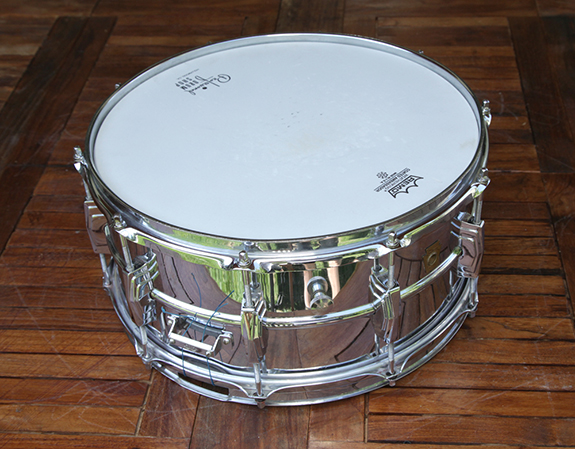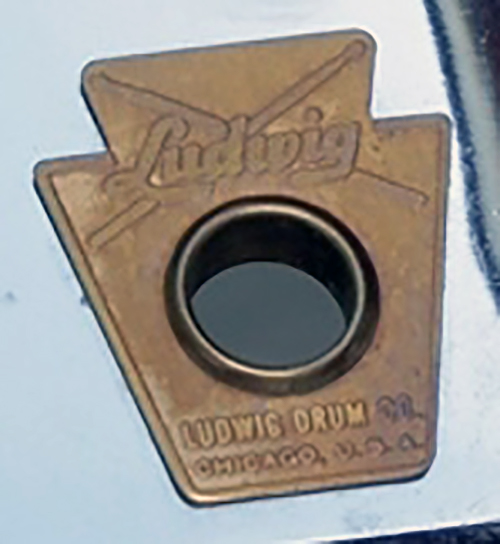"Here are a couple of pics of the World War II collection. The L&L is completely restored. The 1st version WFL (with the rolling bomber snare) werepurchased new, played for a year at home and put in the closet for 70+ years - they still have the original Calf heads on them. I am the 2nd owner. A BDP Rollin Bomber kit with a very rare 10" off set lug tom. I am the second owner as well. At the show I will also have a 1st version (Cecil Stupe design) WFL internal tune kit in WMP that I am restoring."
Read more1938 WFL Concert Twin Strainer
The quest for rare, one-off, special order Street/Parade drums continues.
This latest small condominium comes from Bill Wanser and Olympic Drums & Percussion, Portland Oregon. Thanks goes to Bill who allowed me to print the story that was in the item description.
“Notes: This is a beautiful and rare WFL Twin Strainer concert field drum in original White Marine Pearl wrap. These drums were designed with two independently controlled sets of snares as described in the 1941 catalog. This design allows the player to switch between the two types of snares in an instant. All parts are original, including the drum key, and in excellent condition. The white marine pearl wrap is also in excellent condition with the only blemish being a small cigarette burn next to one of the lugs. This was caused no doubt by a relaxing drummer called to action on short notice and placing his still burning cigarette behind the tension rod. The snares are original gut and wire wound silk. The calf heads are newly tucked heads on the original flesh hoops. All chrome plated hardware is in excellent condition. This drum was used by the original owner in the Arizona State University marching band in the 1930’s. It then lived in a closet until the mid 1990’s when it was found and used in the Phoenix Symphony. An excellent sounding concert field drum that will also make an attractive addition to any collection.”
1938 WFL #482 12 x 16 DELUXE MODEL CONCERT PARADE DRUM
The Shell: The 3-ply shell is in great shape. The WMP still has a lot of white and the only blemish is the cigarette burn mentioned in the above description. The interior is clean. An easy cloth wipe down was all that was needed.
The Hardware: All of the chrome hardware is original and in great shape even the 8 notoriously unstable Zephyr lugs. The twin strainers work well and feel smooth. There was no work that was needed to be done on this drum.
I’m sure that this drum was concertized many times by Bill Wanser (Principle Percussionist, Phoenix Symphony, ret.)...now it’s “museumized.”
Enjoy!
Splitting Hairs
“A rose by any other name would smell as sweet”… a famous Shakespearean quote from Romeo and Juliet. What has that got to do with drums you ask? I know I am beginning to sound like a “One Note Samba". As noted in my last NSMD submission, I am no Ludwig expert BUT it occurs to me that a commonly used reference of “transition badge” is, in fact, a misnomer. The badge above on the left has the reigning title, but the one on the right smells sweeter to me.
A little history…The Ludwig & Ludwig Drum Company was founded in the spring of 1909 by brothers William F. and Theobald Ludwig, manufacturing a bass drum pedal. Crude pedals of the day were “…not powerful or fast enough for the fast rag-time tempos” and the new Ludwig creation became an immediate success. So much so that the brothers began spending more time manufacturing rather than playing drums. That is, until Theobald fell victim to the great Flu Epidemic in 1918 and died at a young age of 29. By demand, William F. took over and devoted 100% of his professional career to manufacturing. Ludwig & Ludwig became the world’s largest drum company in the 1920’s, surpassing Leedy Drums. World War I put a damper on all non-war related manufacturing, but Ludwig was awarded a substantial contract from the US Government for rope tensioned drums and the company continued. After the war, returning musicians were in-demand for theater orchestras and Ludwig’s success flourished.
From William F, Ludwig Sr.’s booklet, 75 Years A Drummer…My Life At The Drums:
“In 1929, as the well-remembered depression drew near, some of us became, perhaps unduly, concerned about the future. The Stock Market collapse choked business and we owed money on our new building (built in 1923). After considerable deliberation, it was decided that the best way for Ludwig & Ludwig to ride out the storm would be to merge with the G.C. Conn Co. of Elkhart, Indiana.”
The Conn Company was already cash-strapped from the purchase of the Leedy Drum Company earlier. Conn proposed a merger with Ludwig receiving $1,000,000 of preferred Conn Stock. Facing bankruptcy, Ludwig was forced to accept. Unfortunately, the Market crash devalued the option to $100,000. Ludwig, being the eternal optimist and being at odds with the Conn business model (which included not only another drum company but a full line of musical instruments) decided,
“In the year 1937…to start all over again in the drum manufacturing business and bought the 20,000 square foot factory building at 1728 N. Damen Ave. in Chicago…The new firm was named the Wm. F. Ludwig Drum Co.”
Conn was quick to notice and had their attorneys file for trademark infringement (Conn owned the Ludwig name). Ludwig Sr. was forced to change the company name to WFL Drum Company. Knowing the brand recognition of the Ludwig name, he wisely inscribed his logo badges to include “Wm. F. Ludwig, Founder”. Conn was enraged but Ludwig was totally within his right, a totally legal procedure."
Son Wm. F. Ludwig, Jr. joined the company one year later and albeit a slow start, the WFL Drum Company began to grow. World War II soon erupted but with some innovate designs to overcome the ensuing government metal restrictions together with Ludwig’s uncanny ability to secure government contracts, the WFL Drum Company received “the largest contract for field drums that had ever been placed with a single manufacturer.” Post war sales flourished with the war-weary population turning to music to relieve their depression. That coupled with the signing of Buddy Rich as an endorser, WFL, with Ludwig at the helm, became a major contender once again. Rich’s endorsement was not without pain though. WFL Jr. later recounted,
“My six most feared words were ‘Buddy Rich is on line two.'”
Still, the path was definitely silver lined, especially when Ludwig Sr. got the call of his dreams. Conn had a number of set backs including a 110 day strike of their labor force. In 1951, in an effort to consolidate their efforts they merged the Leedy and Ludwig & Ludwig names to offer the Leedy & Ludwig Drum Company. By 1955, lack of direction coupled with some design failures forced Conn to reconsider keeping drums in their instrument offering. The decision was made to sell the drum line…the Leedy name to Slingerland, the Ludwig name would go full circle, back to the Ludwig family. Ludwig Sr. continues,
“after exactly twenty-five years…I ‘owned’ my own name once more!”
That same year WFL offered a new catalogue with Buddy Rich proudly displayed on the cover and a WFL badge that still contained Wm. F. Ludwig, Founder at the bottom. The drums produced at this time however (with some exceptions) had badges that were stamped “WFL” at the top and “Ludwig Drum Co Chicago USA” at the bottom. The 1957 catalogue includes a WFL badge with this “Ludwig Drum Co. Chicago USA” inscription at the bottom. This continued until 1958 (I have seen 1958 date-stamped WFL drums with this badge). Then about 1959 the so-called “transition stamp” badge appeared with “Ludwig” at the top and “Drum Company” at the bottom. My question is, why is this the “transition badge” when the prior badge was emblazoned with “WFL” and Ludwig”? Isn’t that clearly the transition? When both names are included after the acquisition from Conn in 1955? I clearly remember in 1956 (see the April 2013 NSMD article “Taking the Driver’s Seat Of A Time Machine”) when the proprietor of Ballou’s Drum Shop in Dayton, Ohio, where my parents bought my set of WFL’s exclaimed, “Those drums are now being made by the Ludwig family.” It was a big deal at the time.
My take on it is, Ludwig was a great promoter. He also knew the value of brand recognition. After building the Ludwig name, only to have it taken away, he again built the WFL name (with the help of including his name as the founder). After seeing the Ludwig name denigrated by poor decisions and marketing by the Conn Company, he realized a quick name switch from WFL to Ludwig was definitely not in order. Though he was ecstatic to “own his own name once more!”, he wisely made the badge transition over a three year period that included both the WFL and Ludwig names. I know there are those that will fall back on the “they used whatever was available” theory. There is validity to that theory when applying it to parts like footboards and throw offs…sure, use up the remaining old logo parts but badges? This is the hallmark of the company. Ludwig’s emphatic reclaiming of his name, yet with proper marketing savvy, would contradict. Yet, almost all historical accounts mark the blue label badge as the first “Ludwig” badge after the reclaiming of the Ludwig name in 1955.
Wake Up Call - WFL vs. Ludwig
OK people, we need to be a bit more imaginative. I mean, if you have the bucks and money is no object, by all means just go for the high-end stuff. But if you are like me, and the bank account is limited, then a little effort is required. Yeah, I wish I could buy every Gladstone drum that came along like I did when no one knew what they were or who he was (well, practically no one). But with the escalating prices of vintage drums, I have to be more creative. Personally, I am in rapt ecstasy over the current price trend of vintage drums. I genuinely surprised and amused when I see vintage drum collectors whine and cry (sometimes belligerently) over these price trends. DUDE, your collection is going up in value. OK, you can think the $165,000 this and the $65,000 that is absurd, but the $50 this and $100 that, you bought 10 years ago is going up too.
Be that as it may (some people love to whine), if you are on the hunt don’t limit yourself. I’ll give you a recent example from my personal experience. I am far from being a Ludwig expert but if I have heard it said once that the COB Ludwig Supraphonic is the best sounding metal snare, I’ve heard it a thousand times. That coupled with the dilemma of determining if a vintage Ludwig metal snare is indeed brass, I was surprised to see one go for the “cheap” on eBay. Click here to see the auction page.
OK so I am also not a Ludwig collector (last NSMD article notwithstanding) but for a second, I considered jumping into the fray, if anything to see what all the hoopla was all about. Then I thought “BASTA” (enough!) stay focused Chet! But, there has to be someone out there who needs this drum and it was only a three-day auction. So, little ‘ol benevolent me thought “put this up on Facebook.” I have two Facebook accounts, my personal one and one I created for Billy Gladstone. Gladstone’s site has more friends than mine (I can’t understand why) so to get the word out I posted the eBay auction with the description “I am not a Ludwig expert, but aren’t these WFL era Supraphonic snares rare? And because it is that old, doesn’t that signify that it is the desired COB shell? A bit rough but it could be brought back. Better hurry…only 2 days left…” Good friend Todd Reemy commented “in my day I sold 150 or more COB Ludwig's...of that number just 2 were WFL...I've always said they were the best sounding of the bunch with Trans badge era being 2nd...” In his day, Todd went by “The Drum Detective” moniker when he was in the retail vintage drum business. And “Dective” he was. His posts in the “For Sale” section in NSMD made my mouth water. This of course, gave my assumption validity so I passed this information along to the seller.
Hey, what goes around comes around. I have had many a helping hand in my day. I knew he would receive “Buy It Now” offers so I wanted to warn him. The seller, who seemed a bit naïve by his eBay description of the drum, was most appreciative and posted my comments in the listing.
When I sent the message one day into the auction, the listing had a paltry $172.49 current bid (up from and opening $149.99 start bid) with only 7 bids and 149 views. The numbers subsequently went up, bids to 22 and a current bid of $701.99 the final day of the auction. I, feeling like the Good Samaritan, was curious where the auction would end… 538 views, 33 bids, with a winning bid of $1009.99. At first I thought “He did well.” Then I searched eBay for other COB Ludwig snares and found this Ludwig Supraphonic COB that went for $1300.
OK, it is pretty. Yes, “Minty”…god I hate that word…when is anyone going to learn the true definition of the word “mint”? read eBay’s take on the subject. My personal definition of mint and that of coin collectors is one word “Uncirculated.” That means untouched by human hands. So if it is still sealed in the original box, it is mint. “New old stock” is exactly that, unsold, new, but not mint. Be that as it may, Todd, whom I consider an expert, said, “in my day I sold 150 or more COB Ludwig's...of that number just 2 were WFL.” That puts the odds at 75 to one, no? OK, I’m not saying the “fair condition” WFL is worth $74,449.25 more than the “Original” Ludwig but less? I don’t think so.
Yes, Mr. WFL is not cosmetically as nice as Mr. Ludwig, but therein is the answer. With a little imagination, read “elbow grease”, it is definitely 75 times the drum. Unless a drum is mint, I personally like to see patina. It gives the instrument character. It has been used, played, enjoyed. Patina does not include dirt and rust so some work is required here. Again, my personal call is less is more. I will not use a buffing wheel. If it cant be removed by hand, it is patina. The bent rim (being brass) could easily be straightened. Imagine what a little work will do for this drum.








